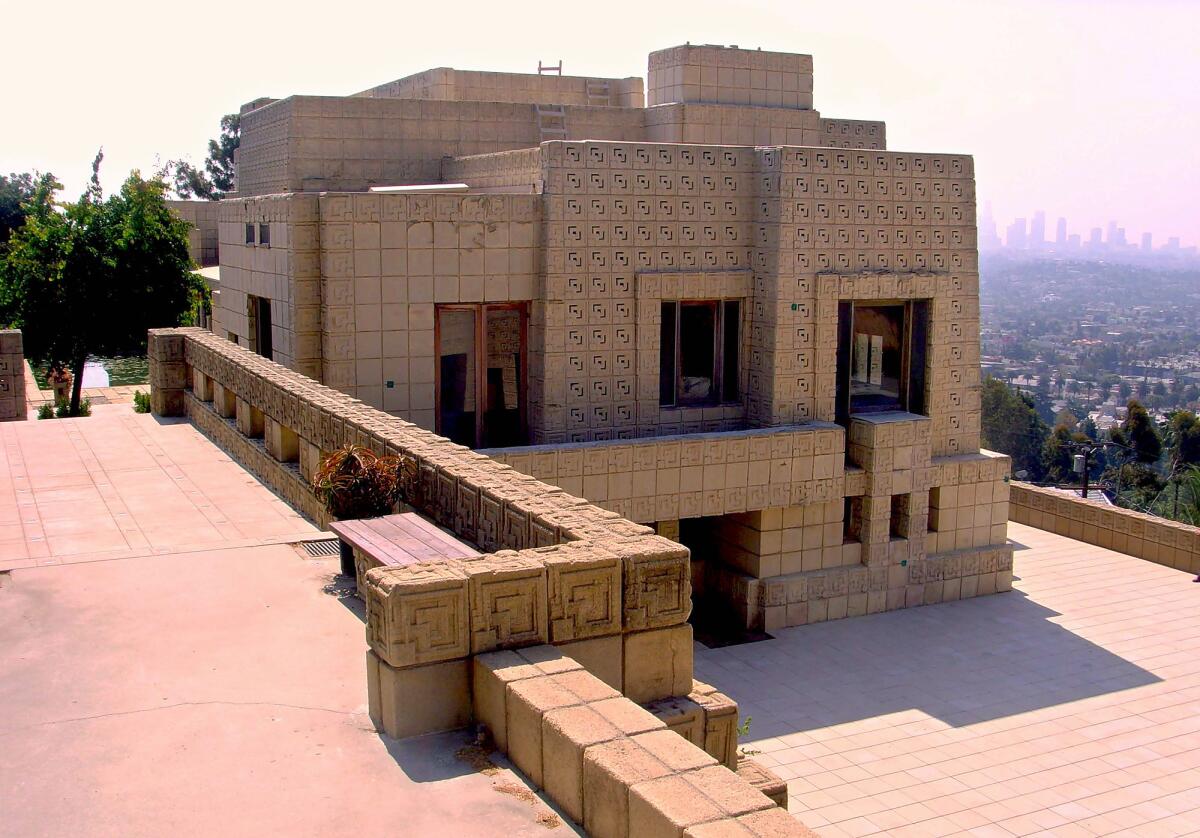From the Archives: The best houses of all time in L.A.

Frank Lloyd Wright, Los Feliz, 1924
The largest and loudest of Wright’s four concrete-block houses in L.A., the Ennis House suggests what the greatest of Modernists would have done with a commission from the Maya Empire 700 years earlier. A heavy, elongated mass constructed of 16-by-16-inch concrete blocks (most textured with an ornate pattern) and sited majestically on a hilltop overlooking Griffith Park, the building appears to be more than a house -- an elegant fortification, perhaps, or a temple.
No sooner can you get out the words “best houses in Southern California” than hands will go up asking what that means, reflecting the subjectivity for compiling such a list. Clearly, there’s more than one way to measure the beauty, utility and significance of any house, but the architects, preservationists and professors who took part in our survey were allowed to apply the term however they felt was appropriate -- weighing combinations of personal taste, originality, historical importance and iconic clout.
We asked an expert panel for its top 10 picks in Southern California homes. The results: Schindlers, Neutras, Wrights -- and more than a few surprises.
Panelist Hitoshi Abe, the Japanese-born chairman of UCLA’s department of architecture and urban design, explained: “I tried to select the houses that reflected the life of Los Angeles to a foreigner or traveler, not as a person living in them.” So, Abe put at the top of his ballot not John Lautner’s Chemosphere or Silvertop, but the architect’s Elrod House in Palm Springs. As displayed in the 1971 James Bond film “Diamonds Are Forever,” the home’s massive concrete roof encasing a view of mountains, desert and pool helped define Southern California to a young man on the other side of the Pacific.
If there is a theme to the top 10 list, it is Modernism in its various forms, an acknowledgment of the important role that Southern California has played in the history of modern architecture, beginning with the Craftsman homes of Greene & Greene at the start of the last century, continuing with Irving Gill’s take on the Pueblo past and Frank Lloyd Wright’s Maya-flavored textile block houses, then followed by the space-shifting inventions of Rudolph Schindler and Richard Neutra. Later, the influential post-World War II Case Study houses commissioned by Arts & Architecture magazine produced lasting democratic visions of glass and steel wrought by Charles and Ray Eames, Pierre Koenig, Craig Ellwood and others.
The houses in the top 10 offer a reminder that Los Angeles -- and Southern California -- have served as a prominent laboratory for new ways of living for the last 100 years. Architects, many from other parts of the country and the world, took on the role of social engineers, not only adapting to the climate and topography but also configuring the human connection to nature, exposure to the (once, at least) salubrious open air and the psychological impact of floor plans and interiors
The houses profiled here are all famous to one degree or another, but arguments will ensue about omissions. For instance, there’s a house on the list by Ray Kappe but none by Frank Gehry.
“Ray is a quiet talent,” said Stephen Kanner, who has jointly curated shows of Kappe’s work at the Architecture and Design Museum in Los Angeles. There are no ranch houses by Cliff May or anything more recent than 1968. Missing is Neutra’s International-style landmark Lovell Health House in Los Feliz, the first all-steel-frame house anywhere, an inspiration to a generation of architects.
Also missing are examples of two styles that symbolize Los Angeles to many: Spanish Colonial Revival and the beach house.
“I wanted to have one Spanish on the list, but I couldn’t think of one,” Culver City architect Steven Ehrlich said.
“I think there’s a sense that the Spanish Colonial is so ubiquitous, it’s a group, not one individual house,” said panelist Linda Dishman, head of the Los Angeles Conservancy, who nevertheless put actress Diane Keaton’s house, a 1920s Spanish Colonial by Ralph Flewelling, on her ballot.
“It’s incredible to me how few good beach houses there are,” said Los Angeles architect Ron Radziner, singling out Richard Meier’s Malibu house as an exception. Schindler’s Lovell House in Newport Beach would be another.
Several on the panel said their choices were based on the emotional but unmistakable feeling that certain houses are “timeless,” accomplishments of design that transcend fashion and professional whim. Who can say for sure what makes a house timeless?
“The sense for the perception of architecture is not the eyes,” Schindler once said, “but living.” Still, Ehrlich reminds us that architects as judges are likely guided more by aesthetics than marketable features. “As architects,” he said, “we are not focused on the size of the kitchens or closets.”
More to Read
Sign up for The Wild
We’ll help you find the best places to hike, bike and run, as well as the perfect silent spots for meditation and yoga.
You may occasionally receive promotional content from the Los Angeles Times.










